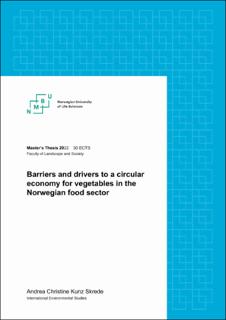| dc.description.abstract | Food systems are pressing the environment in multiple ways. Moreover, some of these pressures are due to inefficient resource use. It is estimated that as much as one third of all food being produced globally is lost or wasted. One of the most wasted food categories globally is fresh fruit and vegetables. In order to avoid the crossing of planetary boundaries, scientific and political communities have signaled the urgent need to change current practices in the global food system. As a response to this, the concept of circular economy is increasingly being recognized as a possible approach to create more sustainable food systems. However, there is a need for more knowledge on barriers and drivers to a circular economy transition, in order to move from theory to practice. With the aim of contributing to such knowledge, this study investigates the barriers and drivers to a transition to a circular economy for vegetables in the Norwegian food system. Through a qualitative case study, perspectives from leaders in businesses working in the various components of the value chain for vegetables have been collected and analyzed. The study takes on a systems perspective and holds the ambition of gaining a greater understanding of how the barriers and drivers are relevant and manifested across the value chain, as well as how these factors are connected to other actors, institutions, and spheres in the greater system. The findings of this study indicate that central barriers are: hindering regulations; lack of political incentives and economic risk; the size and standardization of economic processes; consumer preferences; the conflict between vegetables and supporting resources; knowledge gaps and lack of awareness; lack of holistic thinking and collaboration; lack of willingness to change; and power structures in the value chain. Furthermore, the identified drivers are: increased knowledge and awareness; circular approaches are becoming profitable; political responsibility, incentives, and guidelines; collaboration and holistic thinking; new technologies; and strategic division of power. Thus, the drivers are both direct responses to the perceived barriers, or separate factors seen to enable circular initiatives. Moreover, this study finds that many of the identified factors affecting a transition to a circular economy for vegetables are interlinked, overlapping and dependent on each other. This should be taken into consideration when creating measures aimed at facilitating a transition to a circular economy for vegetables in the Norwegian food system. | en_US |

